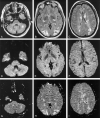Posterior reversible encephalopathy syndrome: prognostic utility of quantitative diffusion-weighted MR images
- PMID: 12063238
- PMCID: PMC7976914
Posterior reversible encephalopathy syndrome: prognostic utility of quantitative diffusion-weighted MR images
Abstract
Background and purpose: The recently described posterior reversible encephalopathy syndrome (PRES) classically consists of reversible vasogenic edema in the posterior circulation territories, although conversion to irreversible cytotoxic edema has been described. We hypothesized that the extent of edema has prognostic implications and that diffusion-weighted MR imaging (DWI) can help predict the progression to infarction.
Methods: Twenty-two patients with PRES and 18 control subjects were examined with isotropic DWI. Nineteen regions of interest (ROIs) were systematically placed, and apparent diffusion coefficients (ADCs) were computed and correlated with T2 and DWI signal intensity in each ROI.
Results: T2 signal abnormalities were always present in territories of the posterior circulation. Anterior circulation structures were involved in 91% of patients. ADC values in areas of abnormal T2 signal were high. More extensive T2 signal abnormalities were seen in patients with a poor outcome than in patients who recovered. In six patients (27%), areas of high DWI signal intensity were seen with ADC values that were paradoxically normal, which we called pseudonormalized. Abnormal T2 signal intensity and high ADC values surrounded these areas. Follow-up images in two patients showed progression to infarction in pseudonormalized regions.
Conclusion: Vasogenic edema in PRES involves predominantly the posterior circulation territories, but anterior circulation structures are also frequently involved. The extent of combined T2 and DWI signal abnormalities correlate with patient outcome. High DWI signal intensity and pseudonormalized ADC values are associated with cerebral infarction and may represent the earliest sign of nonreversibility as severe vasogenic edema progresses to cytotoxic edema.
Figures








References
-
- Hinchey J, Chaves C, Appignani B, et al. A reversible posterior leukoencephalopathy syndrome. N Engl J Med 1996;334:494–500 - PubMed
-
- Ay H, Buonanno FS, Schaefer PW et al. Posterior leukoencephalopathy without severe hypertension: utility of diffusion-weighted MRI. Neurology 1998;51:1369–1376 - PubMed
MeSH terms
LinkOut - more resources
Full Text Sources
Other Literature Sources
Medical
